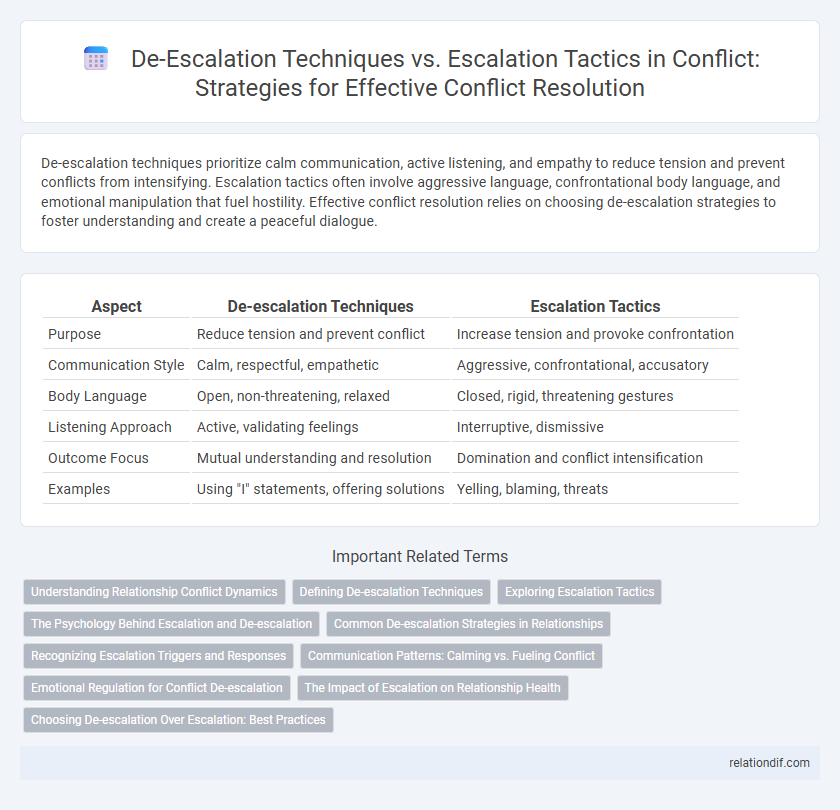De-escalation techniques prioritize calm communication, active listening, and empathy to reduce tension and prevent conflicts from intensifying. Escalation tactics often involve aggressive language, confrontational body language, and emotional manipulation that fuel hostility. Effective conflict resolution relies on choosing de-escalation strategies to foster understanding and create a peaceful dialogue.
Table of Comparison
| Aspect | De-escalation Techniques | Escalation Tactics |
|---|---|---|
| Purpose | Reduce tension and prevent conflict | Increase tension and provoke confrontation |
| Communication Style | Calm, respectful, empathetic | Aggressive, confrontational, accusatory |
| Body Language | Open, non-threatening, relaxed | Closed, rigid, threatening gestures |
| Listening Approach | Active, validating feelings | Interruptive, dismissive |
| Outcome Focus | Mutual understanding and resolution | Domination and conflict intensification |
| Examples | Using "I" statements, offering solutions | Yelling, blaming, threats |
Understanding Relationship Conflict Dynamics
Understanding relationship conflict dynamics is crucial for applying effective de-escalation techniques, which include active listening, empathy, and emotional regulation to reduce tension and prevent misunderstandings. Escalation tactics often involve blame, defensiveness, and aggressive communication that intensify conflicts and damage trust. Prioritizing de-escalation fosters healthier dialogue, promotes problem-solving, and preserves relational bonds in high-stress situations.
Defining De-escalation Techniques
De-escalation techniques are deliberate strategies employed to reduce tension and prevent conflict from intensifying by promoting calm communication and empathy. These methods include active listening, maintaining a non-threatening posture, and using clear, respectful language to defuse hostility. Effective de-escalation minimizes emotional responses and encourages cooperative problem-solving instead of aggressive confrontation.
Exploring Escalation Tactics
Escalation tactics in conflict involve deliberate actions such as aggressive communication, provocation, and intimidation designed to increase tension and pressure the opposing party. These strategies often include amplifying threats, mobilizing allies for support, or employing psychological manipulation to gain a strategic advantage. Understanding these escalation methods is critical for anticipating conflict dynamics and developing effective response plans.
The Psychology Behind Escalation and De-escalation
Escalation tactics trigger the amygdala's fight-or-flight response, heightening stress and aggression in conflicts, while de-escalation techniques engage the prefrontal cortex, promoting rational thinking and emotional regulation. Understanding the psychological mechanisms such as cognitive appraisal and emotional contagion helps in applying calming strategies like active listening and empathy to reduce tension. Neurobiological studies reveal that calming the sympathetic nervous system through controlled breathing or non-threatening body language effectively reverses the cycle of escalation.
Common De-escalation Strategies in Relationships
Common de-escalation strategies in relationships include active listening, which involves paying full attention to the partner's concerns without interrupting, and using calm, non-threatening body language to reduce tension. Empathy expression helps validate emotions, fostering understanding and preventing further conflict escalation. Setting clear, respectful boundaries also promotes healthier communication and encourages problem-solving over confrontation.
Recognizing Escalation Triggers and Responses
Recognizing escalation triggers such as heightened emotions, aggressive language, or body tension enables timely intervention to prevent conflict intensification. De-escalation techniques like active listening, calm verbal responses, and maintaining open body language counteract these triggers effectively. Understanding common escalation patterns allows individuals to choose responses that diffuse hostility and promote constructive dialogue.
Communication Patterns: Calming vs. Fueling Conflict
De-escalation techniques rely on calm, empathetic communication patterns, such as active listening, using neutral language, and validating emotions to reduce tension and foster mutual understanding. Escalation tactics often involve aggressive language, interrupting, and blaming, which fuel conflict by increasing defensiveness and emotional intensity. Effective conflict resolution hinges on replacing fueling communication patterns with calming strategies to break the cycle of confrontation and promote dialogue.
Emotional Regulation for Conflict De-escalation
Emotional regulation is a critical de-escalation technique that helps individuals manage intense emotions during conflicts, preventing escalation tactics such as aggressive language or hostile behavior. Techniques like deep breathing, mindful awareness, and cognitive reframing reduce emotional arousal and promote calm communication. Mastering emotional regulation improves conflict outcomes by fostering empathy, reducing reactivity, and encouraging collaborative problem-solving.
The Impact of Escalation on Relationship Health
Escalation tactics in conflict intensify negative emotions and diminish trust, leading to increased resentment and communication breakdowns. Prolonged escalation damages relationship health by fostering hostility, reducing empathy, and impairing conflict resolution capacity. Effective de-escalation techniques reverse these effects by promoting calm dialogue, enhancing mutual understanding, and preserving emotional bonds.
Choosing De-escalation Over Escalation: Best Practices
Selecting de-escalation over escalation in conflict situations involves active listening, empathizing with the opposing party, and maintaining calm body language to reduce tension. Employing techniques such as open-ended questions and validating emotions fosters communication and prevents further hostility. Implementing these best practices enhances resolution outcomes by focusing on collaboration rather than confrontation.
De-escalation techniques vs escalation tactics Infographic

 relationdif.com
relationdif.com